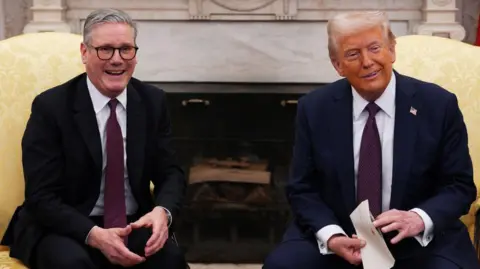The recent dialogue surrounding a potential trade agreement between the United Kingdom and the United States is filled with excitement, yet the complexities of the situation require careful consideration. Vice President JD Vance’s optimistic remarks about the possibility of a UK-US trade deal merit deeper examination, particularly regarding the nuances of how the term “deal” is understood on both sides.
The events following Prime Minister Sir Keir Starmer’s visit to the White House in February demonstrated a notable shift in terminology; UK officials referred to the negotiations as an “economic deal,” deliberately avoiding the notion of an extensive free trade agreement encompassing a wide range of goods. This shift indicates a more cautious approach intended to sidestep the contentious issues that had previously plagued negotiations during former President Trump’s administration. There, discussions around medicine pricing and food standards created significant roadblocks. Back then, Trump’s negotiations were heavily influenced by how closely the UK would adhere to European Union regulations post-Brexit.
Currently, it appears that the focus of the proposed “deal” has transitioned toward collaboration in science, technology, and artificial intelligence, with the added advantage of possibly avoiding tariffs. However, an underlying challenge persists—the United States has enacted a 10% tariff on UK imports under what it terms “reciprocal tariffs.” This situation raises significant questions regarding the overall trading relationship: the UK typically imports more from the US than it exports, thereby complicating the premise of negotiation.
The essence of the negotiations hinges on the understanding that the 10% tariff is positioned as a baseline across various trading partners, rather than a negotiable figure, indicating an overarching strategy from the US to maintain uniformity in its tariff system. The implication is that creating exceptions for the UK could lead to broader trade discrepancies with other nations who currently face the same tariffs.
Notably, the UK’s position in global trade negotiations is particularly unique. Compared to other nations, which have seen higher tariffs imposed—especially those on electronic products in East Asia—the UK’s situation compellingly contrasts, especially since it does not contribute to the US trade deficit. The current atmosphere of negotiations could leave the UK with limited leverage, especially as it navigates potential grievances regarding automotive tariffs (which stand at 25%) and the ongoing complexity involving electronics.
As these negotiations unfold, they coincide with critical recalibrations in the UK’s post-Brexit relationship with the European Union. Upcoming discussions slated ahead of the UK-EU summit reveal both parties striving for a “high ambition-high alignment” reset that simplifies agricultural exports. The US has shown a vested interest in these matters and could potentially influence the UK-EU negotiation dynamics, particularly with regard to strategies aimed at containing China’s economic influence.
This multifaceted scenario becomes even more intricate when one considers the emerging need for the US to solidify advantageous agreements with its closest allies in light of recent turbulence in financial markets, including instability in US government debt. The current landscape has potentially shifted the balance of leverage in the UK’s favor more than previously understood. While the Prime Minister may opt not to wield this newfound leverage, the reality remains that the US cannot afford to allow the UK to stall or withdraw from dialogues.
In conclusion, while the notion of a UK-US trade agreement evokes hopeful sentiments, the details involved are crucial and deserving of meticulous scrutiny. As the broader geopolitical repercussions unfold, the dynamics at play in these negotiations will undoubtedly have lasting impacts on both nations. The interplay of tariffs, economic strategies, and international relations underscores the complexity of creating meaningful agreements in today’s increasingly interconnected world.



